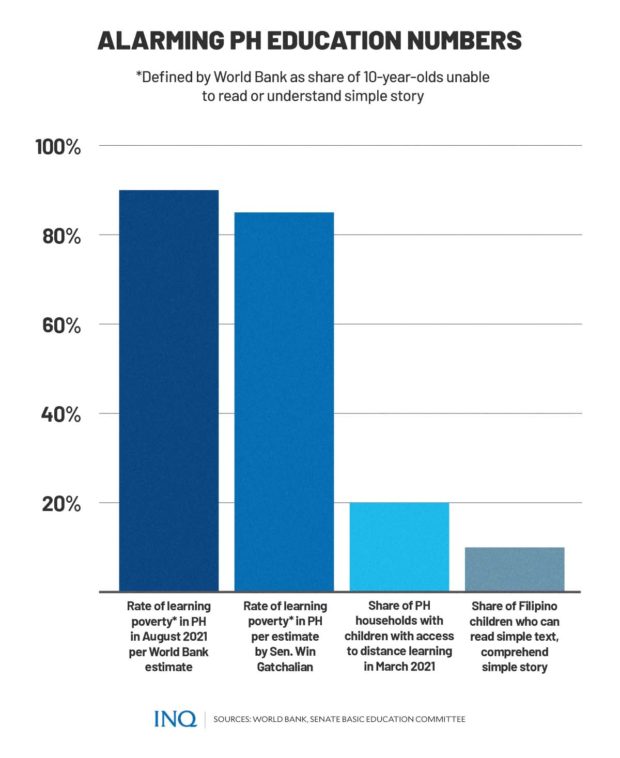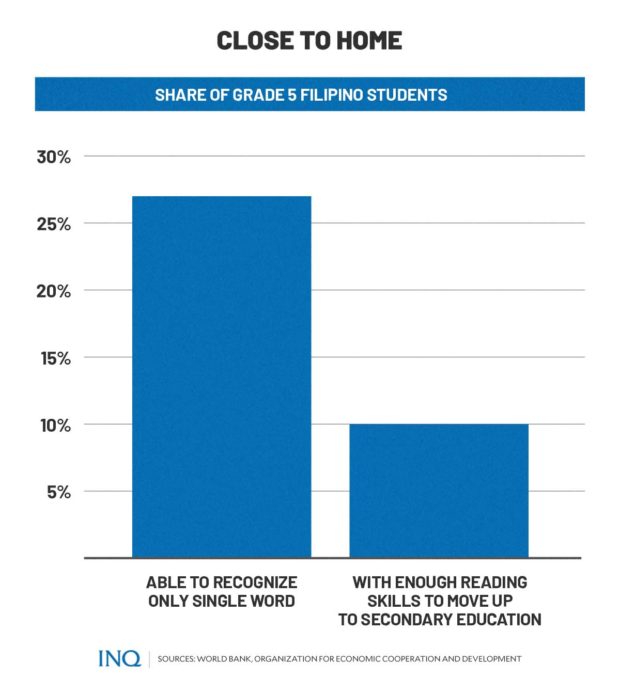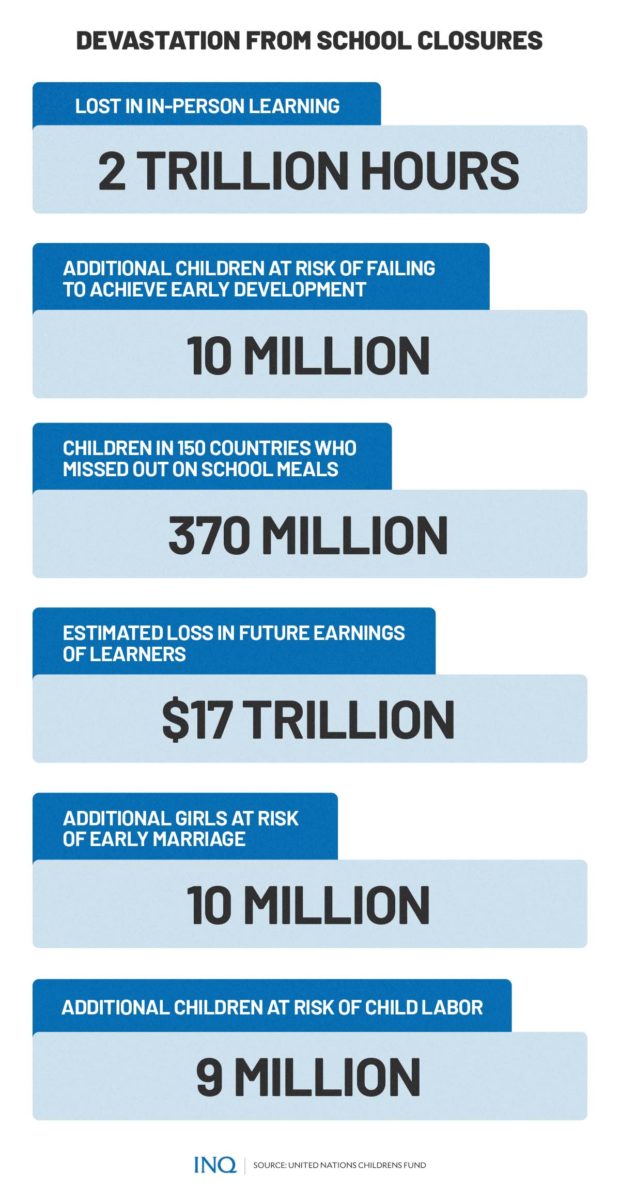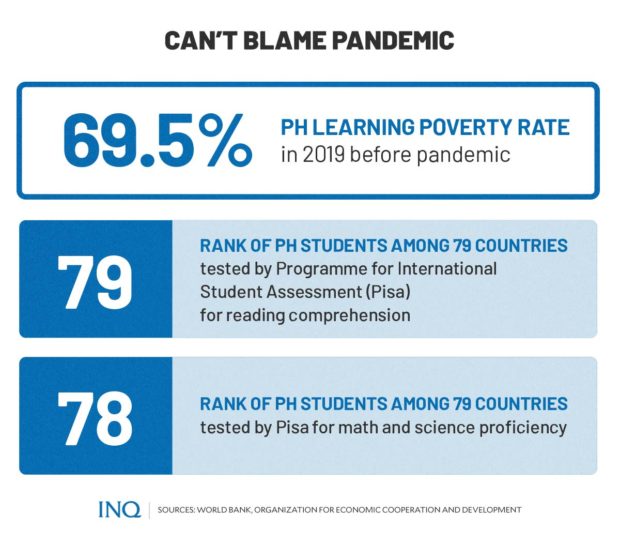When 10-year-olds can’t read: The dulling of PH education
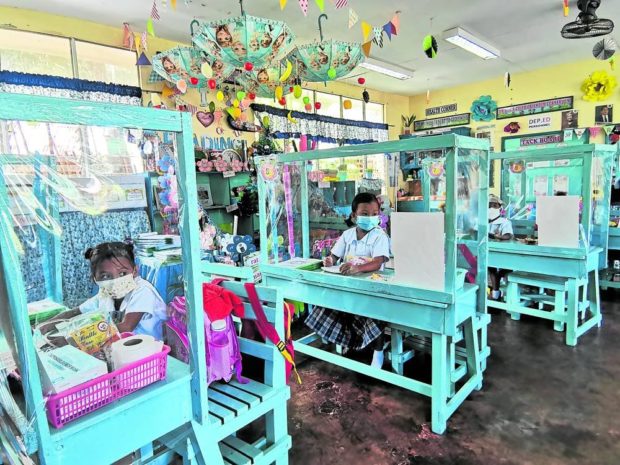
FILE PHOTO: Learners at Napo Elementary School in Barangay Napo, Linamon, Lanao del Norte are separated with makeshift cubicles as face-to-face classes start on Monday, November 15, 2021. DIVINA M. SUSON
MANILA, Philippines—Over two years into the pandemic, and despite the gradual reopening of schools in many countries including the Philippines, the impact of long lockdowns on children’s education has become evident—now more than ever.
Less than 10 percent of Filipino children can read simple text or comprehend a simple story—based on a joint report by the United Nations Children’s Fund (Unicef), UN Educational, Scientific and Cultural Organization (Unesco) and the World Bank titled “Where are We on Education Recovery?”
The finding, according to Senate Basic Education Committee Chair Sherwin Gatchalian, “translates to a learning poverty of more than 85 percent.”
Learning poverty, as defined by the World Bank, refers to the share of 10-year-olds who cannot read or understand a simple story.
Several other studies and reports have highlighted similar issues experienced by many Filipino schoolchildren amid the COVID-19 pandemic.
In this article, INQUIRER.net will look back at some of the findings on the condition of Filipino schoolchildren these past few years, as well as the implications of different challenges to education on learners across the globe.
Pandemic, pre-pandemic scorecard
It is undeniable that education was among the sectors changed so drastically by the COVID-19 pandemic.
Schools nationwide were forced to close when physical classes were considered too risky to hold as SARS-Cov-2, the virus that causes COVID-19, is transmitted mainly from human to human.
Confronted with this, the Department of Education (DepEd) turned to what is now known as blended learning and required schools to shift from conventional to “hybrid” learning, so-called because it involved a mix of distant online learning and modules delivered to students’ doorsteps or picked up from DepEd sites.
READ: The promises and pitfalls of blended learning in PH
However, a World Bank report released in November last year showed that as schoolchildren in the Philippines struggled with studying remotely, learning poverty in the country reached a new high of 90 percent as of August that same year.
The WB report, titled “Remote Learning During COVID-19: Lessons for Today” found that as of March 2021, distance schooling in the Philippines covered only 20 percent of households with schoolchildren—the lowest rate alongside Ethiopia, one of the world’s poorest countries.
According to its calculations, WB said this had worsened learning poverty in the Philippines to as high as 90 percent by August 2021—alongside the lack of access to the internet and slow connection which also hindered remote learning.
READ: WB: Remote learning jacked up learning poverty in PH to 90% in 2021
In 2019, or before COVID-19 struck, learning poverty in the Philippines was already 69.5 percent.
Prior to the pandemic, results of the Programme for International Student Assessment (Pisa) by the Organization for Economic Cooperation and Development (OECD) showed that Filipino students fared worst among 79 countries in reading comprehension and second-lowest in both mathematical and scientific literacy.
READ: Worst PH ranking in math, science, reading prompts DepEd review
A 2019 study conducted by Unicef and the Southeast Asian Ministers of Education Association (SEAMEO) showed that only 10 percent of Grade 5 children in the Philippines excelled in mathematics, reading, and writing
READ: ‘Small percentage’ of PH 5th graders proficient in math, reading, writing – study
Meanwhile, results of the 2019 Southeast Asia Primary Learning Metrics (SEA-PLM) showed that 27 percent of Filipino children in Grade 5 were able to recognize only single words, while only 10 percent of them developed reading proficiency to allow their proper transition to secondary education.
A high percentage of Filipino students was also in the lowest bands for mathematical and writing literacy.
READ: Filipino pupils lagging in 3Rs, Southeast Asia tests show
The Trends in International Mathematics and Science Study 2019 (TIMSS) published in December 2020 showed that Filipino children ranked lowest among 58 countries in an international assessment for mathematics and science for Grade 4 students.
READ: PH’s Grade 4 students lowest in math, science around the world — int’l study
Making matters worse
Aside from the impact on learning poverty, Unicef’s latest joint report stated that school closures, which have so far caused two trillion hours of in-person learning lost, have more long-term implications such as:
- 10 million more children at risk of falling off track in early childhood development
- 370 million children in 150 countries missed out on school meals
- 17 trillion dollars estimated to be lost in future earnings of current learners
- 1/3 increase in anxiety and depression symptoms for adolescents
- 10 million more girls at risk of early marriage between 2020-2030
- 9 million additional children at risk of child labor by end of 2022
Further, Unicef Philippines Representative Oyunsaikhan Dendevnorov said in a separate report last year that “the associated consequences of school closures – learning loss, mental distress, missed vaccinations, and heightened risk of dropout, child labor, and child marriage – will be felt by many children, especially the youngest learners in critical development stages.”
“For too many children, missing school means that they may never return; a parent losing his or her income means children go hungry; and increased pressures and stress on families mean that children experience more violence,” said Inger Ashing, Chief Executive Officer of Save the Children International.
In 2020, the study “No Education, No Protection: What school closures under COVID-19 mean for children and young people in crisis-affected contexts”, said that worldwide, because of the physical closure of schools, students “have lost an important space that offered them stability, even as the environment around them grew ever more uncertain.”
“Movement restrictions, the closure of schools, loss of income, isolation, overcrowding, and high levels of stress and anxiety are increasing the likelihood that children experience and observe physical, psychological, and sexual abuse at home – particularly those children already living in violent or dysfunctional family situations,” Unicef said.
Schools, Unicef emphasized, provided “interconnected” services to children, especially on their social, emotional, psychological, and physical health and wellbeing.
“A long lockdown kept many children from learning and put them at greater risk of online abuse, mental health issues, and other activities that are important for their physical and emotional growth,” Unicef said.
READ: As COVID shuts down schools, homes become unsafe places for kids
Reopening schools
The recently-released joint report also said that schools in the Philippines had been closed from face-to-face classes for the longest time among 122 countries that the report covered.
On average, schools in the East Asia and Pacific region have been fully closed for 18 weeks and 20 weeks globally, as of February this year.
To address the impact of COVID-19 on the education sector, Gatchalian said the country should open schools for limited in-person classes and that the government should implement a comprehensive learning recovery program nationwide.
“We must focus on the recovery of the education sector to ensure that the schoolchildren are learning properly,” he said in a statement.
Last month, DepEd announced that over 10,000 public and private schools have so far been allowed to resume limited face-to-face classes.
“A total of 9,994 public schools and 212 private schools are already at the participating level. These are the nominated schools that are now under Alert Levels 1 and 2. These are the schools that can already reopen for face-to-face classes” Assistant Education Secretary Malcolm Garma said
“In fact, many of these have already reopened for limited face-to-face classes. So the total of these participating schools is 10,196 schools,” he added.
READ: DepEd: Over 10,000 schools OK’d to resume limited in-person classes
Last January, President Rodrigo Duterte approved the proposal of DepEd to expand in-person classes in public and private schools in areas under Alert Levels 1 and 2, following the pilot run of physical classes last year.
READ: Duterte OKs expansion of limited in-person classes in areas under Alert Level 1, 2
Addressing the issue
To address the learning crisis among students worldwide, Unicef presented five key actions for education recovery and urged governments to:
- Reach every child and retain them in school
- Assess learning levels
- Prioritize teaching the fundamentals
- Increase catch-up learning and progress beyond what was lost
- Develop psychosocial health and well-being so every child is ready to learn
DepEd recently said that it is crafting a “learning recovery plan” to address learning gaps caused by the COVID-19 pandemic.
“As more schools open their doors for physical learning, the department is currently crafting a learning recovery program as part of our post-pandemic efforts,” Education Secretary Leonor Briones said in a statement.
“We have to ensure that our interventions are effective so that everyone can catch up and accelerate their learning,” she added.
READ: DepEd crafts recovery plan to address learning gaps caused by COVID-19
TSB
For more news about the novel coronavirus click here.
What you need to know about Coronavirus.
For more information on COVID-19, call the DOH Hotline: (02) 86517800 local 1149/1150.
The Inquirer Foundation supports our healthcare frontliners and is still accepting cash donations to be deposited at Banco de Oro (BDO) current account #007960018860 or donate through PayMaya using this link.
